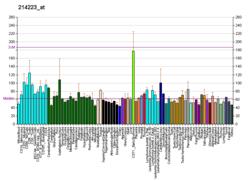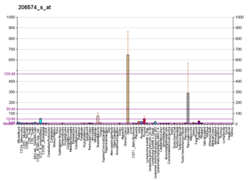PTP4A3
Protein tyrosine phosphatase type IVA 3 is an enzyme that in humans is encoded by the PTP4A3 gene.[5]
The protein encoded by this gene belongs to a small class of prenylated protein tyrosine phosphatases (PTPs). PTPs are cell signaling molecules that play regulatory roles in a variety of cellular processes. This class of PTPs contain a PTP domain and a characteristic C-terminal prenylation motif. Studies of this class of PTPs in mice demonstrated that they were prenylated proteins in vivo, which suggested their association with cell plasma membrane. Overexpression of this gene in mammalian cells was reported to inhibit angiotensin-II induced cell calcium mobilization and promote cell growth. Two alternatively spliced variants exist.[5]
References
- 1 2 3 ENSG00000275575 GRCh38: Ensembl release 89: ENSG00000184489, ENSG00000275575 - Ensembl, May 2017
- 1 2 3 GRCm38: Ensembl release 89: ENSMUSG00000059895 - Ensembl, May 2017
- ↑ "Human PubMed Reference:".
- ↑ "Mouse PubMed Reference:".
- 1 2 "Entrez Gene: PTP4A3 protein tyrosine phosphatase type IVA, member 3".
Further reading
- Zeng Q, Hong W, Tan YH (1998). "Mouse PRL-2 and PRL-3, two potentially prenylated protein tyrosine phosphatases homologous to PRL-1". Biochem. Biophys. Res. Commun. 244 (2): 421–7. doi:10.1006/bbrc.1998.8291. PMID 9514946.
- Dayton MA, Knobloch TJ (1998). "Multiple phosphotyrosine phosphatase mRNAs are expressed in the human lung fibroblast cell line WI-38". Receptors & signal transduction. 7 (4): 241–56. PMID 9633825.
- Zeng Q, Si X, Horstmann H, et al. (2000). "Prenylation-dependent association of protein-tyrosine phosphatases PRL-1, -2, and -3 with the plasma membrane and the early endosome". J. Biol. Chem. 275 (28): 21444–52. doi:10.1074/jbc.M000453200. PMID 10747914.
- Matter WF, Estridge T, Zhang C, et al. (2001). "Role of PRL-3, a human muscle-specific tyrosine phosphatase, in angiotensin-II signaling". Biochem. Biophys. Res. Commun. 283 (5): 1061–8. doi:10.1006/bbrc.2001.4881. PMID 11355880.
- Saha S, Bardelli A, Buckhaults P, et al. (2001). "A phosphatase associated with metastasis of colorectal cancer". Science. 294 (5545): 1343–6. doi:10.1126/science.1065817. PMID 11598267.
- Wang J, Kirby CE, Herbst R (2003). "The tyrosine phosphatase PRL-1 localizes to the endoplasmic reticulum and the mitotic spindle and is required for normal mitosis". J. Biol. Chem. 277 (48): 46659–68. doi:10.1074/jbc.M206407200. PMID 12235145.
- Strausberg RL, Feingold EA, Grouse LH, et al. (2003). "Generation and initial analysis of more than 15,000 full-length human and mouse cDNA sequences". Proc. Natl. Acad. Sci. U.S.A. 99 (26): 16899–903. doi:10.1073/pnas.242603899. PMC 139241. PMID 12477932.
- Pathak MK, Dhawan D, Lindner DJ, et al. (2003). "Pentamidine is an inhibitor of PRL phosphatases with anticancer activity". Mol. Cancer Ther. 1 (14): 1255–64. PMID 12516958.
- Zeng Q, Dong JM, Guo K, et al. (2003). "PRL-3 and PRL-1 promote cell migration, invasion, and metastasis". Cancer Res. 63 (11): 2716–22. PMID 12782572.
- Bardelli A, Saha S, Sager JA, et al. (2004). "PRL-3 expression in metastatic cancers". Clin. Cancer Res. 9 (15): 5607–15. PMID 14654542.
- Kozlov G, Cheng J, Ziomek E, et al. (2004). "Structural insights into molecular function of the metastasis-associated phosphatase PRL-3". J. Biol. Chem. 279 (12): 11882–9. doi:10.1074/jbc.M312905200. PMID 14704153.
- Kim KA, Song JS, Jee J, et al. (2004). "Structure of human PRL-3, the phosphatase associated with cancer metastasis". FEBS Lett. 565 (1–3): 181–7. doi:10.1016/j.febslet.2004.03.062. PMID 15135076.
- Wu X, Zeng H, Zhang X, et al. (2004). "Phosphatase of Regenerating Liver-3 Promotes Motility and Metastasis of Mouse Melanoma Cells". Am. J. Pathol. 164 (6): 2039–54. doi:10.1016/S0002-9440(10)63763-7. PMC 1615773. PMID 15161639.
- Gerhard DS, Wagner L, Feingold EA, et al. (2004). "The Status, Quality, and Expansion of the NIH Full-Length cDNA Project: The Mammalian Gene Collection (MGC)". Genome Res. 14 (10B): 2121–7. doi:10.1101/gr.2596504. PMC 528928. PMID 15489334.
- Kato H, Semba S, Miskad UA, et al. (2005). "High expression of PRL-3 promotes cancer cell motility and liver metastasis in human colorectal cancer: a predictive molecular marker of metachronous liver and lung metastases". Clin. Cancer Res. 10 (21): 7318–28. doi:10.1158/1078-0432.CCR-04-0485. PMID 15534108.
- Li J, Guo K, Koh VW, et al. (2005). "Generation of PRL-3- and PRL-1-specific monoclonal antibodies as potential diagnostic markers for cancer metastases". Clin. Cancer Res. 11 (6): 2195–204. doi:10.1158/1078-0432.CCR-04-1984. PMID 15788667.
- Polato F, Codegoni A, Fruscio R, et al. (2006). "PRL-3 phosphatase is implicated in ovarian cancer growth". Clin. Cancer Res. 11 (19 Pt 1): 6835–9. doi:10.1158/1078-0432.CCR-04-2357. PMID 16203771.
- Peng L, Jin G, Wang L, et al. (2006). "Identification of integrin alpha1 as an interacting protein of protein tyrosine phosphatase PRL-3". Biochem. Biophys. Res. Commun. 342 (1): 179–83. doi:10.1016/j.bbrc.2006.01.102. PMID 16472776.
- Rouleau C, Roy A, St Martin T, et al. (2006). "Protein tyrosine phosphatase PRL-3 in malignant cells and endothelial cells: expression and function". Mol. Cancer Ther. 5 (2): 219–29. doi:10.1158/1535-7163.MCT-05-0289. PMID 16505094.
- Radke I, Götte M, Kersting C, et al. (2006). "Expression and prognostic impact of the protein tyrosine phosphatases PRL-1, PRL-2, and PRL-3 in breast cancer". Br. J. Cancer. 95 (3): 347–54. doi:10.1038/sj.bjc.6603261. PMC 2360632. PMID 16832410.
This article is issued from
Wikipedia.
The text is licensed under Creative Commons - Attribution - Sharealike.
Additional terms may apply for the media files.









